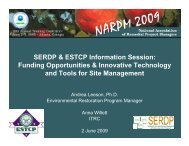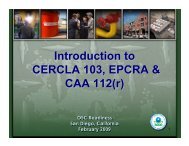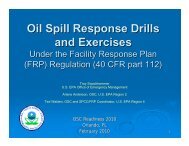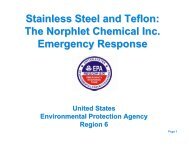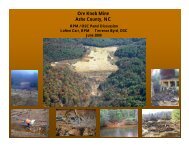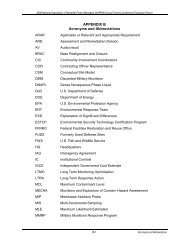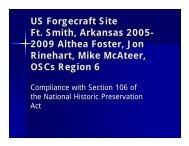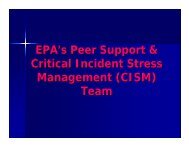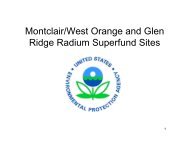FINAL Ricin EPA San Diego.pdf
FINAL Ricin EPA San Diego.pdf
FINAL Ricin EPA San Diego.pdf
Create successful ePaper yourself
Turn your PDF publications into a flip-book with our unique Google optimized e-Paper software.
<strong>Ricin</strong>:<br />
A phytotoxin from the castor bean<br />
(<strong>Ricin</strong>us communis)<br />
Dr. Mark A. Poli, PhD, DABT<br />
US Army Medical Research Institute of Infectious<br />
Diseases, Fort Detrick, Maryland
<strong>Ricin</strong> is a Plant Toxin
From: Sarah L. Corbett, Valdosta State University<br />
Castor Beans
Castor Beans are an Important<br />
Agricultural Commodity<br />
• Commercial uses<br />
• Paints, dyes, varnishes<br />
• Lubricant<br />
• Purgative/laxative<br />
• Source of sebacic acid, used<br />
in the production of nylon<br />
• Animal food supplement<br />
• Fertilizer<br />
From: Thai Castor Oil Industries
But Inside the Beans . . .<br />
(267 a.a.)<br />
• MW approx 66 Kd<br />
• Inhibitor of protein synthesis<br />
• Depurination of A4324 disrupts<br />
binding of elongation factor 2<br />
(EF2) leading to termination of<br />
protein synthesis<br />
(262 a.a.)<br />
Model courtesy of Dr. Mark Olsen, USAMRIID
How it Works . . .<br />
• B chain is lectin, which directs binding to galactose residues<br />
on cell surface proteins<br />
• Endocytic uptake is primarily (but not exclusively) through<br />
uncoated pits<br />
• Once in endosomes, either<br />
S recycled to cell surface<br />
S degraded in lysosomes<br />
S enter the cytosol via the Golgi apparatus<br />
• Separation of A and B chains<br />
• Enzymatic cleavage of specific adenosine residue from 28S<br />
ribosomal subunit, which inhibits binding of EF-2
Clinical Features . . .<br />
Ingestion:<br />
• dose-dependent dependent latency period (up to 10 hr)<br />
• fever, thirst, sore throat, headache<br />
• nausea, vomiting, abdominal cramps<br />
• severe diarrhea, GI hemorrhage, vascular collapse<br />
• necrosis of the liver, spleen, kidneys, lymph nodes<br />
• death in 3-53<br />
5 days<br />
`
Clinical Features . . .<br />
Inhalation:<br />
• dose-dependent dependent latency period (8 – 24 hr)<br />
• fever, nausea, tightness in the chest<br />
• cough, dyspnea<br />
• hypothermia and cyanosis secondary to massive<br />
pulmonary edema<br />
• upper airway necrosis<br />
• death in 36-48 hr (high dose)
Pulmonary Exposure
Medical Management is Limited<br />
to Supportive Care . . .<br />
For inhalation exposure:<br />
S treat the acute lung injury and pulmonary edema<br />
For ingestion:<br />
S gastric lavage, , cathartics<br />
S i.v. . fluids and electrolyte replacement
Prophylaxis . . .<br />
• Physical protection<br />
S respiratory protection (mask)<br />
S not dermally active<br />
• No vaccine available for human use<br />
S vaccine candidates scheduled for<br />
advanced development
Diagnostics . . .<br />
Typically direct capture immunoassays<br />
Hand held assays are available<br />
S New Horizons Diagnostics, Columbia, MD<br />
S Tetracore, Gaithersburg, MD<br />
S Jant Pharmacal, Encino, CA<br />
Activity assays<br />
Immunohistochemistry
Direct Capture Immunoassay<br />
biotinylated antibody<br />
ricin<br />
ruthenylated antibody<br />
streptavidin-coated paramagnetic bead
Flow Cell<br />
photodiode<br />
electrode<br />
magnet<br />
Magnetic beads
Clinical Matrices Are Not a Problem<br />
7000<br />
10% Human Serum<br />
4000<br />
Urine<br />
6000<br />
Relative ECL Units<br />
5000<br />
4000<br />
3000<br />
2000<br />
1000<br />
Relative ECL Units<br />
3000<br />
2000<br />
1000<br />
0<br />
0.0 0.1 0.2 0.3 0.4 0.5 0.6 0.7 0.8 0.9 1.0 1.1<br />
<strong>Ricin</strong> (ng/ml)<br />
0<br />
0.0 0.1 0.2 0.3 0.4 0.5 0.6 0.7 0.8 0.9 1.0<br />
<strong>Ricin</strong> Conc (ng/ml)
Activity Assay<br />
5’<br />
RNA substrate<br />
A G C G G G A G A<br />
3’ C C C U C U<br />
G<br />
A<br />
dA<br />
G<br />
Free toxin<br />
(pH= 4.1)<br />
Deadenylation site<br />
Deadenylated<br />
product<br />
5’<br />
*<br />
Me 2 ED, beads, Ru-ODN<br />
Detect<br />
RuODN anneals to<br />
unblocked product<br />
5’-Ru
ECL-Based <strong>Ricin</strong> Activity Assay<br />
8<br />
Signal/Background<br />
7<br />
6<br />
5<br />
4<br />
3<br />
2<br />
1<br />
0.00 0.25 0.50 0.75 1.00 1.25 1.50 1.75 2.00<br />
<strong>Ricin</strong> (ng/ml)
Immunohistological Detection<br />
in Tissue Samples<br />
Courtesy of Dr. Chad Roy, USAMRIID
Harnessing Cytotoxicity for Medical<br />
Advantage: Immunotoxins<br />
• Cytotoxic activity can be targeted<br />
to individual cell types by covalently<br />
linking toxins to antibodies specific<br />
for cell surface receptors<br />
• Approach is limited by side effects:<br />
S nonspecific hepatic cytotoxicity<br />
S vascular leak syndrome<br />
• Currently undergoing phase 1<br />
clinical trials for the treatment of<br />
lymphoma, myeloma, and graft-vs.-<br />
host disease
Side Effects Have Limited the<br />
Use of Immunotoxins as<br />
Cancer Treatment . . .<br />
• Nonspecific hepatotoxicity<br />
S 1980s: Minimized by deglycosylation – stripping of sugar residues<br />
• Vascular Leak Syndrome<br />
S determined to a separate event from cytotoxicity, involving a<br />
different portion of the protein sequence<br />
S single AA substitution eliminated the VLS without affecting<br />
cytotoxicity<br />
S LD 50 in mice increased 5-fold5<br />
S 5x higher dose improved therapeutic value in mouse model (survival<br />
time)<br />
(Smallshaw,, J. et al. (2003) Nature Biotechnology 21:387-391<br />
391)
<strong>Ricin</strong> and The Terrorist
Listed by the CDC as a<br />
Category B Agent . . .<br />
• Moderately easy to disseminate<br />
• Moderate morbidity rates/low mortality rates<br />
• Requires specific enhancements in diagnostic<br />
capacity
Why <strong>Ricin</strong>?<br />
• Extremely potent by aerosol route<br />
S LD 50 in animal models 3-53<br />
µg/kg<br />
• Widely available in large quantities<br />
S grown in third-world nations<br />
• Easily extracted with low technology
A Little Recent History . . .<br />
• 1995: agents discover 130 g of ricin at the Canadian border<br />
• 2002: six terrorist suspects arrested in Manchester, England<br />
• 2003: subtoxic quantities of ricin discovered in the Paris Metro;<br />
thought to be related to a plan to attack the Russian embassy<br />
• 2003: envelope with a threatening note and a sealed container of o<br />
ricin processed at a mail facility in Greenville SC. Note threatened tened to<br />
poison water supplies<br />
• 2004: traces of ricin discovered in the mail room of the Dirksen<br />
Senate Office Building<br />
None of these events resulted in human intoxication . . .<br />
but the toxin is clearly out there!
Possible Mass Casualty<br />
Scenarios . . .<br />
• Distribution into the food or water<br />
supply<br />
• Aerosol dissemination
Distribution in Food or Water . . .<br />
Not a particularly scary scenario<br />
• Poorly absorbed from the GI tract<br />
• LD 50 about 20 mg/kg (mice)<br />
• Death is rare in human intoxications – 2 since<br />
1930
Distribution in Food or Water . . .<br />
• Mass casualty attempt would likely require multi-kg<br />
quantities of pure toxin<br />
• More likely to result in mild intoxication:<br />
S nausea<br />
S vomiting<br />
S diarrhea<br />
• Difficult to differentiate from other foodborne illness
Aerosol Dissemination . . .<br />
The bad news: definitely the worst scenario<br />
• Very toxic by this route – LD 50 3-5 µg/kg*<br />
LD 50<br />
• Particles
Aerosol Dissemination . . .<br />
The good news: it’s s difficult to accomplish<br />
• Efficient aerosol distribution of particles in the<br />
correct size range is very difficult for the non-expert<br />
• Particle size depends upon a variety of factors,<br />
many of them environmental<br />
• Aerosol toxicity is highly dependent upon particle<br />
size
Particle Size is Critical<br />
120<br />
MMAD = 1.0 µm<br />
GSD = 1.3<br />
100<br />
Dose (ng)<br />
80<br />
60<br />
MMAD = 5.0 µ m<br />
GSD = 1.9<br />
MMAD = 12.0 µm<br />
GSD = 1.1<br />
Collison nebulizer vs.<br />
Spinning Top Aerosol Generator<br />
40<br />
20<br />
0<br />
0.1 1.0 10.0 100.0<br />
Aerodynamic diameter (µm)<br />
Roy, C.J, M. Hale, J.M. Hartings, and L. Pitt (2003) Inhalation Toxicology 15:619-638
In the Event of a Mass<br />
Casualty Event . . .<br />
Look for epidemiological clues pointing to a toxin<br />
• Rapid onset of symptoms<br />
• Unusual clusters of cases<br />
• Unexplained deaths among the young or healthy<br />
• Unexplained death of animals or fish<br />
Couple this with<br />
• Laboratory confirmation<br />
• A credible threat
Decontamination . . .<br />
Gross decontamination of patients at the<br />
scene<br />
• Soap and water<br />
• <strong>Ricin</strong> isn’t dermally active Minimal risk of<br />
secondary aerosols<br />
• Risk to health care provider is minimal<br />
Personal protective gear/equipment<br />
• Decon with 0.1% bleach for 15 min
Summary<br />
• <strong>Ricin</strong> is a plant toxin that is widely available and has<br />
a history with terrorist groups/individuals<br />
• Potency considerations make aerosol dissemination<br />
the only real mass-casualty scenario<br />
• Potency by aerosol is highly dependent upon<br />
equipment and environmental conditions<br />
• Should exposure occur, most morbidity will likely be<br />
mild to moderate<br />
• Standard decon; ; minimal risk to responders
Thank you!!




